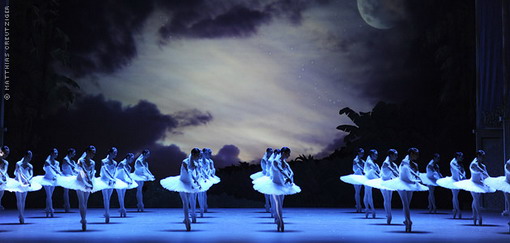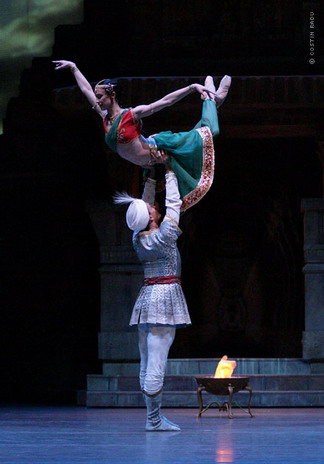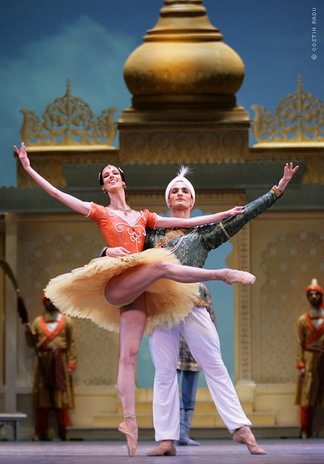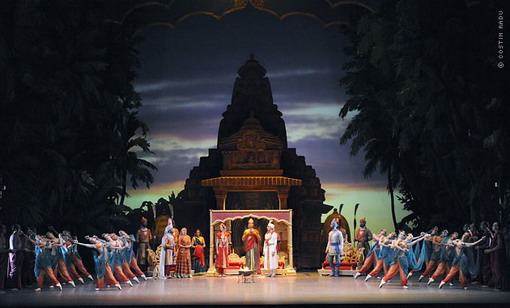La Bayadère – to the Brilliant of the Classic Ballet to Dresden
The ballet company of SemperOper in Dresden had a very unsettled past. It belonged to the most progressive companies in Germany in the 1920s but in 1945 it lost its building and it formed a more universal body after the era of Soviet ballets at the end of the 1970s to come back to the newly-built theatre forty years after the war. It has been among the top ensembles under the guidance of Aaron S. Watkin from Canada. The works by contemporary authors (Forsythe, Dawson, Kylián) can be found in the repertoire as well as pearls of neoclassic and classic legacy. A great stage and an ensemble of about 60 members ask for expensive romantic ballets.
One of them is also La Bayadère, the ballet staged in St. Petersburg in 1877 that undoubtedly ranks among the golden collection of Marius Petipa. Its foreshadow can be found in the early romantic choreography La Péri by Jean Coralli with the libretto created in cooperation with Théophil Gautier, the imaginary father of Giselle, the most famous romantic ballet.

La Bayadère with music by Ludwig Minkus has a lot of common with Giselle; it is a legacy of late romanticism, a ballet with a fairy-tale exotic topic, a pompous set and wonderful dance performances. Despite the fact it is popular all around the world, it has been completely staged only once in the Czech Republic – in Brno in 2003. The story is not notoriously known in our country like The Swan Lake, for example and this is the reason why we remind it in the way they do it in Dresden.
La Bayadère was a professional Indian temple dancer who danced during ceremonies and rituals or for officers' entertainment; only the most talented and most beautiful girls could become la bayadère. Nikiya, the heroine of the ballet, ranks among these girls and she is the first dancer of the very old temple who is secretly in love with Solor, the most noble Indian aristocrat. He is in love with her as well but his rival is the high Brahmin who is rejected by Nikiya and he watches their secret engagement at the sacred fire. Solor is supposed to become a groom of beautiful Hamsatti, the only daughter of a mighty rajah. The Brahmin immediately in forms them about secret lovers. Hamsatti asks for Nikiya and she tries to endear her with expensive gifts and when she is upset with her refusal, she tells her that Solor is her rightful fiancé. Nikiya attacks her rival but she is not able to kill her; however, her fate is sealed. Hamsatti's and Solor's engagement are soon celebrated and the most beautiful temple dancer Nikiya should dance there. Her rival prepares a basket full of flowers as a present from Solor but there is a poisonous snake hidden in it. Dying Nikiya refuses the antidote offered by the Brahmin because she does not want to live without love. Solor seeks oblivion by smoking opium in his rooms. He falls in the world of shadows where he meets a soul of his beloved woman. When he wakes up, he cannot forget about the beautiful vision; nevertheless, he must prepare for the wedding. It is supposed to take place in the temple and the high Brahmin should do the ceremony. However, Solor's love appears to him as well as the basket with flowers and Hamsatti with the rajah urge the Brahmin to speed up the ritual. When their hands are tied, the suppressed anger of gods breaks out, the temple collapses in the gust of a sudden storm and everybody dies. Solor's and Nikiya's souls meet and they find their glory.
forms them about secret lovers. Hamsatti asks for Nikiya and she tries to endear her with expensive gifts and when she is upset with her refusal, she tells her that Solor is her rightful fiancé. Nikiya attacks her rival but she is not able to kill her; however, her fate is sealed. Hamsatti's and Solor's engagement are soon celebrated and the most beautiful temple dancer Nikiya should dance there. Her rival prepares a basket full of flowers as a present from Solor but there is a poisonous snake hidden in it. Dying Nikiya refuses the antidote offered by the Brahmin because she does not want to live without love. Solor seeks oblivion by smoking opium in his rooms. He falls in the world of shadows where he meets a soul of his beloved woman. When he wakes up, he cannot forget about the beautiful vision; nevertheless, he must prepare for the wedding. It is supposed to take place in the temple and the high Brahmin should do the ceremony. However, Solor's love appears to him as well as the basket with flowers and Hamsatti with the rajah urge the Brahmin to speed up the ritual. When their hands are tied, the suppressed anger of gods breaks out, the temple collapses in the gust of a sudden storm and everybody dies. Solor's and Nikiya's souls meet and they find their glory.
As we can see, the whole four-act ballet is almost one string of pas de deux, variations and divertissements. Choreographer Aaron S. Watkin undertook the work with care and respect, we can speak about reconstruction although it is clear that pantomimic part are suppressed and the performance is cool, clear and the plot is continuous. Nikiya's and Hamsatti's roles are almost equal concerning their severity, genre dances of Indian bayaderes are not missing in the temple and at the celebration as well as classical variations on the tips. Thanks to the numerous ensemble and extras, the stage is always crowded – be it courtiers, soldiers or yogis (friends and allies of Solor – they are undoubtedly innovative elements concerning choreographic interpretation; their almost animal movements draw from the principle of contemporary dance).
 The performance has strong atmosphere so even a small accident that can happen to an experienced dancer is quickly forgotten. A viewer does not know if s/he admires soloists' performances or synchronization of the body watching well-coordinated men's jumps or perfect Italian fouettés of their partners. Olga Melnikova and Britt Juleen danced the main roles in the performance that took place on 10th April 2010; Solor was played by Jiří Bubeníček. Both dancers are quite tall but it does not stop them from being technically skilled; Bubeníček is a reliable and very manly partner to both of them with his flexible jumps and confident pirouettes. One of the most impressive parts of the whole ballet is the kingdom of shadows, a dreamy image that is very pious. Aaron Watkin is at the right place because he – unlike others – does not try to "trump" perfect choreography with his own inventions. Discipline is needed for perfection also on the other side – dancers. A well coordinated body, onsets at the same moment, arabesques in one line – it could seem natural but a Czech viewer has unfortunately a very rare possibility to see something like this. We should blame the short time our ballet ensembles have for remembering a piece when they usually rehearse several pieces at the same time. The people in Dresden bet on the block system of performances and the results are indisputable.
The performance has strong atmosphere so even a small accident that can happen to an experienced dancer is quickly forgotten. A viewer does not know if s/he admires soloists' performances or synchronization of the body watching well-coordinated men's jumps or perfect Italian fouettés of their partners. Olga Melnikova and Britt Juleen danced the main roles in the performance that took place on 10th April 2010; Solor was played by Jiří Bubeníček. Both dancers are quite tall but it does not stop them from being technically skilled; Bubeníček is a reliable and very manly partner to both of them with his flexible jumps and confident pirouettes. One of the most impressive parts of the whole ballet is the kingdom of shadows, a dreamy image that is very pious. Aaron Watkin is at the right place because he – unlike others – does not try to "trump" perfect choreography with his own inventions. Discipline is needed for perfection also on the other side – dancers. A well coordinated body, onsets at the same moment, arabesques in one line – it could seem natural but a Czech viewer has unfortunately a very rare possibility to see something like this. We should blame the short time our ballet ensembles have for remembering a piece when they usually rehearse several pieces at the same time. The people in Dresden bet on the block system of performances and the results are indisputable.
But let's go back to the performance. A crafty set – stage design by Arne Walter, costumes by Erik Västhed, light design Bert Dalhuysen – partakes in success. Everything is simple and efficient: all props hang on ropes except for several pieces of furniture and the change of the set between scenes is done without the curtain, only with dim lights and it lasts for a very short time. Despite this fact, the scene is realistic and it reminds us of the expensive performances of late romantic ballets. Colourful costumes can look too bright but Orient and India are simply like that – remember the glitter of Bollywood. La Bayadère is a performance where the world of dreams plays the main role and it has to be excluded from common life, it must smell of gold and exoticism. The overall impression is amplified by the orchestra (Saxon State Orchestra Dresden) conducted by David Coleman, the opera is also well constructed from the acoustic point of view.

A performance like La Bayadère is a prove that a classical repertoire is something that can be exciting and charming if we perceive it in a sensitive and humble way; it can be art that is not dead and it does not necessarily need a modern "format" to allure audience; people's stories have been very similar for centuries, only the props keep changing. Many authors think that if they change the outer props or if they complicate the plot, they will bring the performance closer to contemporary audience. Vivid ovations in the almost sold-out theatre in Dresden prove the fact that the key to interpreting classic ballets is in love of ballet art and trust in power of its artistic impact. Many Czech ensembles could be inspired by Dresden...
Photos: archieves of SemperOper
Translated by: Eliška Hulcová


